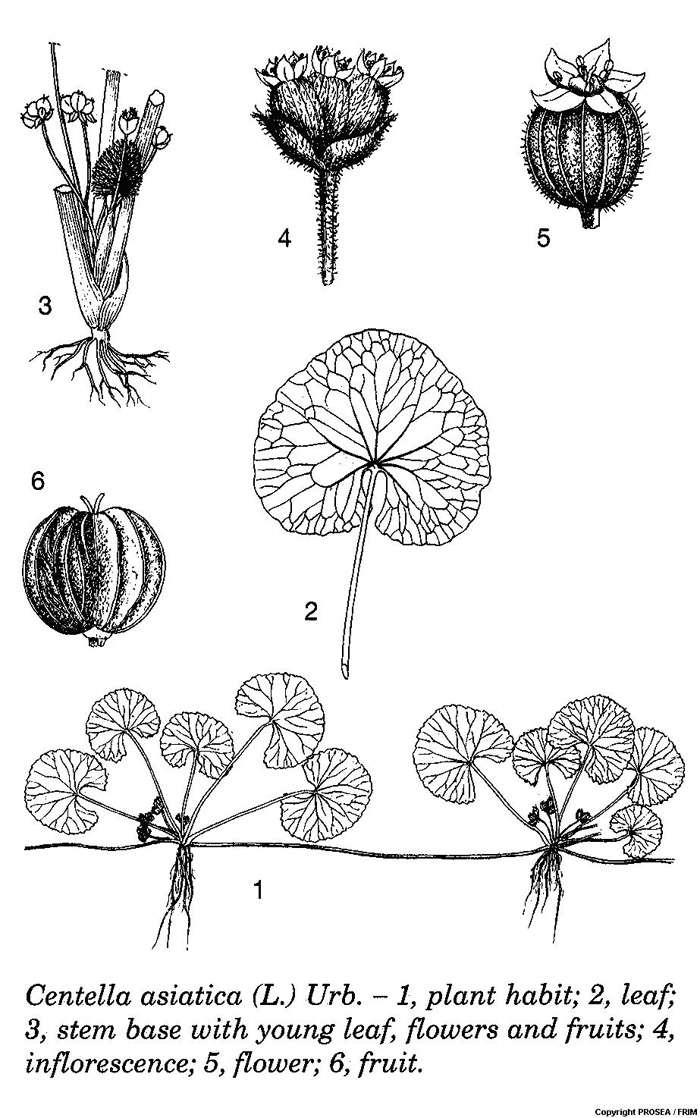Centella asiatica
Family
Umbelliferae
Synonyms
Hydrocotyle asiatica L
Vernacular Names
| Malaysia | Pegaga (General). |
| English | Asiatic pennywort, Indian pennywort, gotu-gotu. |
| Brunei | Pegaga. |
| Indonesia | Daun kaki kuda, pegagan (General), antanan gede (Sundanese). |
| Philippines | Takip-ko-hol, tapingan-daga (Tagalog), hahang-halo (Bisaya). |
| Singapore | Pegaga. |
| Burma (Myanmar) | Min-kuabin. |
| Cambodia | Trachiek kranh. |
| Laos | Phak nok. |
| Thailand | Bua bok (Central), pa-na-e khaa-doh (Karen, Mae Hong Son), phak waen (Peninsular). |
| Vietnam | Rau m[as], t[is]ch tuy[ees]t th[ar]o. |
| French | Hydrocotyle asiatique. |
Geographical Distributions
C. asiatica has a pantropical distribution including South-East Asia and extending into some subtropical regions.
Description
This is a small perennial herb, creeping with long stolons up to 2.5 m long. The rooting system is at the nodes. Its young parts are more or less hairy.
Its leaves are in rosettes form and simple. The lamina is orbicular-reniform, 1-7 cm in diametre, regularly crenate or crenate-dentate, palmately veined and slightly smooth. Petiole is 40(-50) cm long, hairless to hairy, broadened at the base into a leaf-sheath. Stipules are absent.
Inflorescence is an axillary simple umbel, (1-)3(-7)-flowered with sessile middle flower and lateral flowers are with a short pedicel and an involucre that consists of 2 ovate bracts with 0.5-5 cm long peduncles. Flowers are 5-merous bisexual. Sepal is obsolete. Petals are roundish to broadly obovate 1-1.5 mm long, entire, greenish, pinkish or reddish. The petals are 2-lobed disk and plane with elevated margin, arranged alternate with the stamens. The ovary is inferior, 2-celled and 2 styles.
Fruit consists of 2 one-seeded mericarps connected by a narrow junction, separate when mature, oblate-rounded, strongly laterally compressed, 3 mm x 3-4 mm. Its mericarps are distinctly 7-9-ribbed; ribs connected by veins and hairy when young but often becoming hairless.
Seed is laterally compressed.
Seedling is with epigeal germination with 2-4 mm long hypocotyls and they are smooth. The cotyledons are broadly egg-shaped to elliptical, shallowly emarginated at apex and hairless. The epicotyl is absent.
Ecology / Cultivation
C. asiatica occurs in sunny or slightly shaded, damp localities, on fertile soils (preferring sandy loams with much organic mater), e.g. along stream banks, on or near paths, alongside walls and in damp, open grassland, from sea-level up to 2500 m altitude. It is an early coloniser of fallowed land in shifting cultivation systems, but may occur also on recently disturbed habitats and even on undisturbed sites. It may carpet the ground completely, but in regions with a monsoon climate, it is usually only during the rainy season.
Line Drawing / Photograph

Read More
References
- Plant Resources of South-East Asia No 12(1). 1998, .


